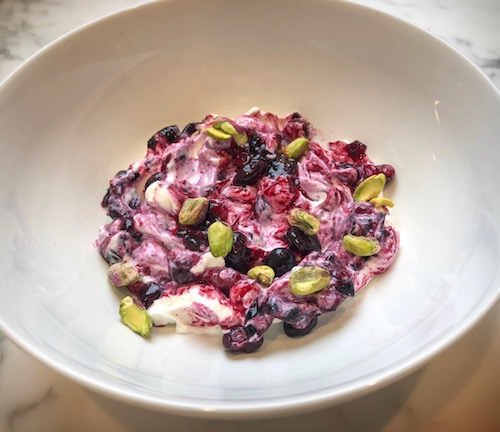If you’ve been with Enara for a bit, you know we love a few things….berries, ancient grains, and wait for it…..Greek yogurt! But what’s the deal with this protein-packed breakfast? Today we’re going to break down all the reasons we love this creamy treat. Not a Greek yogurt fan (yet)? We’ll provide some tips and tricks to make it better suit your liking.
First things first, what are the benefits of plain Greek yogurt?
Protein. One cup of 2% Fage Greek yogurt (brand merely an example) contains 23 grams of protein. This is about the same as 3 ounces of chicken. To compare, one cup of 2% Dannon (non-Greek yogurt) contains 11 grams of protein, about half the amount. But how can Greek yogurt contain more protein than normal yogurt? The answer lies in how Greek yogurt is produced. During production, Greek yogurt is extensively strained to remove excess whey (the watery part of milk), increasing its protein content and giving it a thicker texture.
It’s alive! Yogurt is a fermented food, so it naturally contains probiotics. These are good bacteria similar to the beneficial bacteria found in our gut. Probiotics have been found to aid in digestion and to promote a healthy immune system.
Naturally low in sugar. Plain Greek yogurt (2%) contains 6 grams of sugar. Keep in mind, this isn’t added sugar, but the natural sugars found in lactose. There is an abundance of low-calorie, sugar-sweetened products available at the supermarket these days, but many contain added sugars and/or non-nutritive sweeteners. For example, Dannon “Light & Fit” Vanilla Greek Nonfat yogurt contains 80 calories, 12 grams of protein, and 7 grams of sugar. Great! Right? Let’s give their nutrition label a second look:

Right off the bat, your eyes will scan to the third ingredient, added fructose. Fructose, found naturally in fruit, is broken down by the liver. The benefit of natural fructose is that whole fruit also contains fiber, which slows down carbohydrate absorption. It should be noted the amount of fructose found in whole fruit is minimal compared to the amount found in processed fructose, such as in high fructose corn syrup. In addition to added fructose, this particular yogurt contains sucralose and acesulfame potassium, which are non-nutritive sweeteners. Check out this article for why we don’t recommend these hyperpalatable sweeteners.
Versatility. While on the VLCD, we recommend experimenting with low-calorie alternatives for super flavorful meals. Missing sour cream on top of your chili or tacos? Top with Greek yogurt instead! How about a flavorful sauce on your chicken avocado wrap? Mix Greek yogurt with wasabi or hot sauce and you have a low-calorie, flavorful alternative to mayonnaise.
OK, so what to do if you’re not a fan, and the sugar-sweetened varieties are still calling your name? How about making your own fruit-sweetened Greek yogurt like the photo above? We let one cup of frozen berries sit at room temperature for about 15 times, and then mixed together for 30 seconds. Gently swirl fruit mixture with your Greek yogurt, top with a sprinkle of almonds or pistachios, and voila! You have your own naturally-sweetened parfait.



